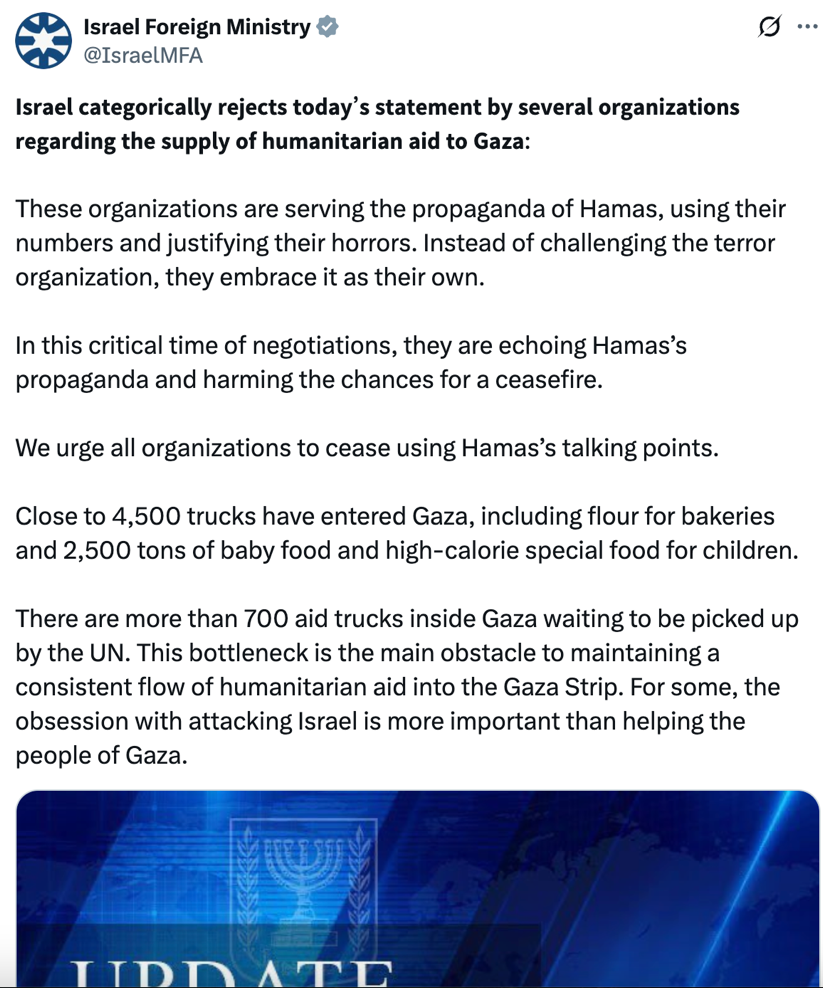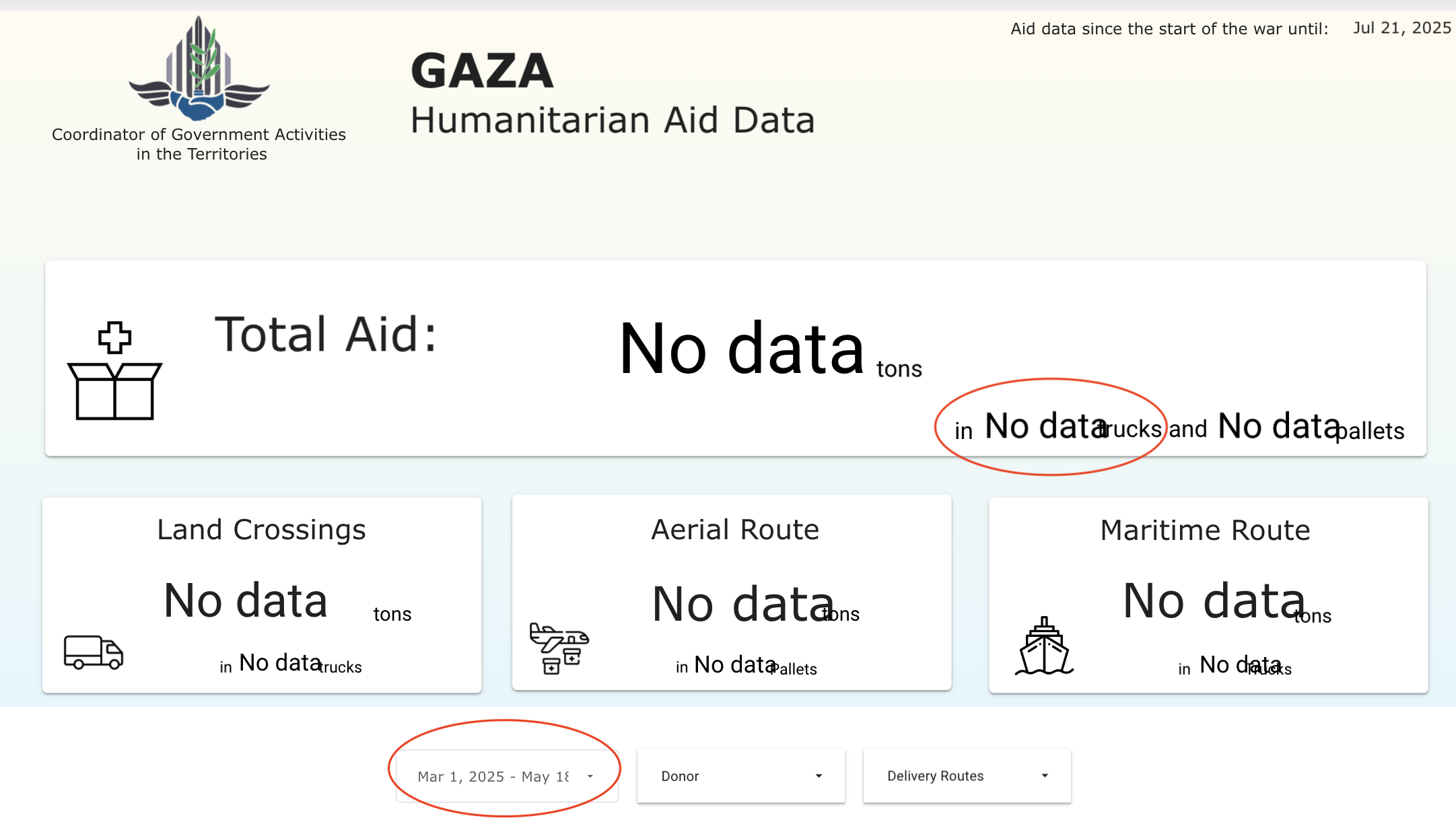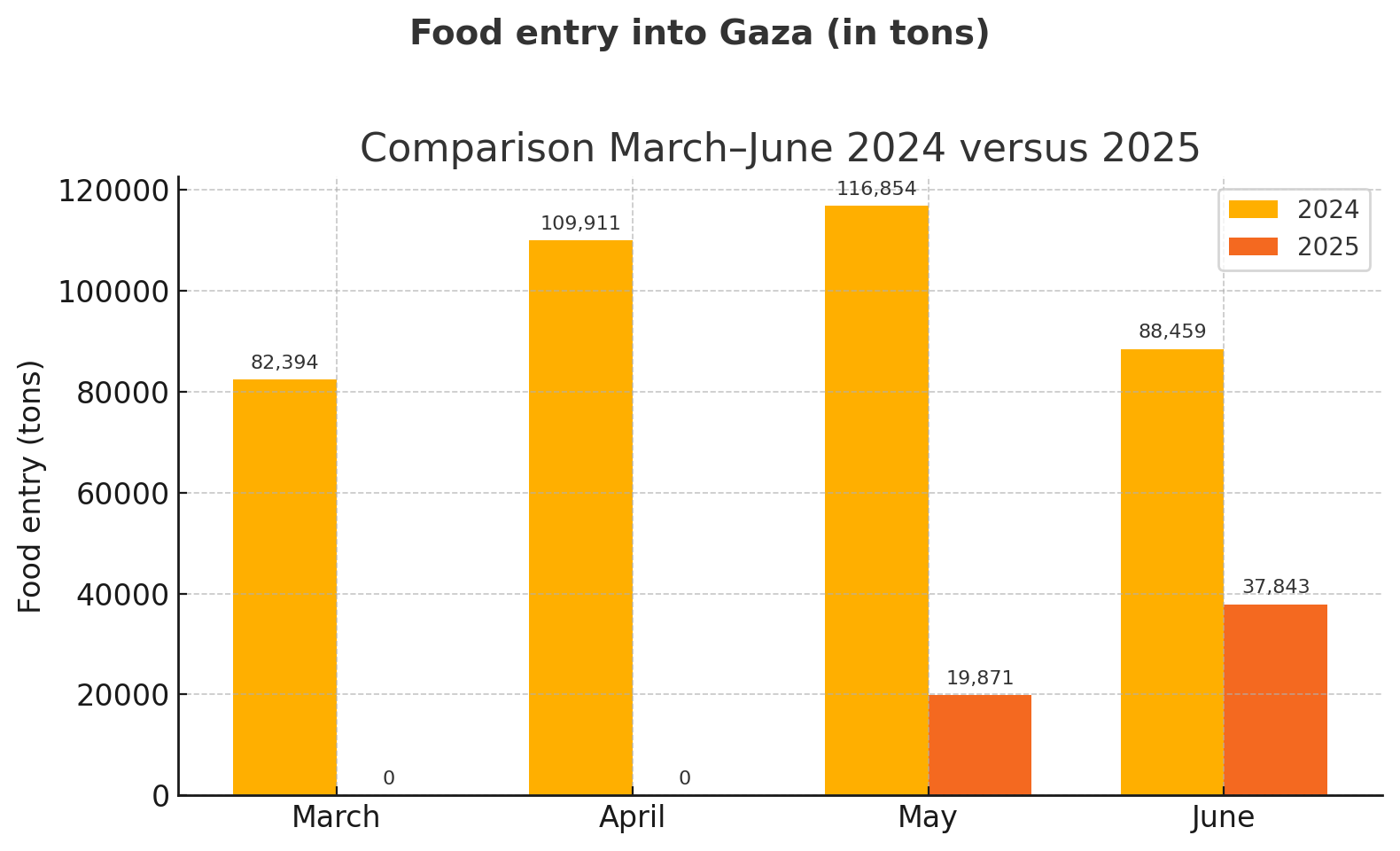
Israel is waging a campaign aimed at eradicating the Palestinian population and life in Gaza and seizing their land. This is being pursued through a wide array of systematic violence as well as technical, bureaucratic, economic, legal and political means.
This blog does not attempt to address the human reality of that genocidal campaign; Palestinians themselves are best positioned to do so. Instead, it attempts to address how Israel, along with its allies and lobbyists, has repeatedly resorted to lies, distortions, and misrepresentation of data. They have consistently sought to discredit and defame humanitarian organisations and other credible actors dedicated to assisting Palestinians and helping the world understand the reality of what happens in both Gaza and the West Bank, including East Jerusalem.
The truth that both Palestinians and humanitarians are trying to tell is one of humanity and inhumanity. Israel, however, systematically attempts to counter this truth with technical maneuvers, legalistic framing, and selective information – leveraging unverifiable data that only it controls. For example, humanitarian organisations and the UN do not have direct access to the crossings into Gaza and nobody can independently verify truck movements.
Furthermore, counting trucks itself is a misleading indicator for humanitarian access. What matters is not what crosses a border, but what reaches people in need. Even after crossing into Gaza, Israeli restrictions, attacks, delayed coordination, and insecurity often block delivery. True access means sustained, safe, and predictable distribution of life-saving assistance – not just trucks at a crossing.
For these reasons, humanitarian organizations and the UN rarely engage in debates over Israeli-controlled figures: the terms of that argument are designed for them to lose. Nevertheless, this blog seeks to cut through the numbers Israel uses to convince especially Western governments that aid is flowing. By unpacking Israel’s own data, we expose what those figures truly represent – and what they conceal.
Israeli Claims versus Statements by Humanitarians
On 23 July 2025, over 100 NGOs issued a joint statement titled “As mass starvation spreads across Gaza, our colleagues and those we serve are wasting away.” Hours later, Israel’s Ministry of Foreign Affairs (MFA) publicly rejected the statement on social media, accusing humanitarian organisations of “serving Hamas propaganda” and “harming ceasefire chances.”
The MFA also claimed that:
- 4,500 aid trucks entered Gaza since May 19
- Over 700 trucks are waiting inside Gaza for UN pick-up
- The “bottleneck” is due to UN logistics, not Israeli restrictions
These tactics are not new: discrediting humanitarian actors by claiming they have ties to Hamas (previously focused on UNRWA, most recently on UN OCHA and others), shifting blame, and hiding behind unverifiable technical details have become standard features of Israel’s narrative. But Israel’s figures themselves warrant scrutiny.

Deconstructing Israel’s Truck Numbers
The headline figure of 4,500 trucks appears significant until placed in context.
Taken at face value, and spread over roughly 65 days (from May 19, when the Israeli militarized distribution schemed misleadingly named the “Gaza Humanitarian Foundation” was established, to July 22), this would equal 69 trucks per day.
As has been well established by humanitarian organisations but also evident from Israel’s own published data, from 1 March to 18 May 2025, no goods entered Gaza at all.

Before October 2023, Gaza received an average of about 500 sealed trucks per working day, each with a much larger capacity than the smaller, open-top trucks currently allowed. That was during a time of far lower humanitarian need and greater self-sufficiency from farming and fishing. In other words, 500 trucks per day is an extremely conservative baseline compared to what would be required now.
To put this into perspective, consider the entire period between March 1 and July 22, which is 144 calendar days. Subtracting weekends and assuming the pre-war pattern of five working days per week, that equals about 102 working days. At 500 trucks per day, at least 51,000 trucks would have been needed just to maintain pre-war levels.
Today, after months of bombardment, infrastructure destruction, and repeated mass forcible displacements, humanitarian experts estimate that a bare minimum of 600 trucks per day would be required to meet basic needs. Over the same period indicated above, with a minimum of 600 trucks entering over 102 days, that would amount to 61,200 trucks.
Instead, Israel admits to allowing 4,500 trucks at most – meaning less than 9% of the pre-war level and an even smaller fraction of what is actually needed today. This shortfall of at least 46,500 trucks is not a logistical oversight. It is the result of a deliberate policy to starve and deprive civilians of aid during one of the worst humanitarian crises the world has experienced in contemporary times.

Food Entry Has Collapsed by 85% since 2024
In the spring of 2024 (around March, April, May, and June), when humanitarian organisations were already reporting child deaths linked to malnutrition under the Israeli-imposed blockade, Israel’s own figures (on the same governmental website already mentioned above) show that 82,394 tons of food entered in March, 109,911 entered in April, 116,854 in May, and 88,459 in June.

One year later, the figures have collapsed: 0 tons in March (a 100% reduction), 0 tons in April (a 100% reduction), 19,871 in May (an 83% reduction), and 37,843 in June (a 57% reduction) compared to the same months in 2024. As such, the amount of food (in tons) entering Gaza between March and June dropped by about 85.5% in 2025 compared to the same period in 2024 (or: only 14.5% of the amount that entered in 2024 during the same time period was allowed to enter in 2025).

This reduction occurred despite warnings by humanitarians and the UN throughout 2024 that the Israeli obstructions and blockade were already killing children, when food volumes were far higher than they are today. If child deaths happened then, what does an 85% reduction mean now? It means famine is here, and it is entirely man-made by Israel and those who enable it.
The UN Inefficiency Myth
The Israeli MFA post furthermore states that hundreds of trucks are “waiting for the UN to pick up inside Gaza,” implying that enough aid is available but delayed because of UN inefficiency. This is a deliberate distortion of reality.
Here is what is actually happening:
- Israeli control of crossings: Israel decides what enters Gaza, when it enters, and in what quantities. Humanitarian agencies have no direct access to crossings; every truck, driver and movement requires individual Israeli approval.
- Israeli control of territory in Gaza: Israel effectively controls almost the entire Gaza Strip. Around 80% of the land has been unilaterally declared a military or “buffer” zone, with Israeli forces deployed throughout. Every humanitarian convoy must cross this territory to reach civilians in Gaza.
- Unworkable conditions: In late June, Israel agreed to a plan for the UN to deliver 20,000 metric tons of food in 14 days, with half allocated to northern Gaza. After 10 days, only one-third of the target was reached – and access to the north was completely shut down by Israel after the first day. None of the conditions Israel committed to for safe and predictable access were consistently met.
- Constant interference: Humanitarian teams face relentless demands from Israeli forces to alter convoy size, routes, and timing – often during active movement. Convoys regularly take 18 hours or more, forcing drivers to operate at night without proper security, breaching the most basic safety standards.
- Looting and collapse of social order: Convoy attacks, the dismantling of the police and all other forms of law and order, prolonged delays caused by constant Israeli re-routing, and deepening humanitarian desperation have fueled widespread looting by both civilians and armed groups. As a result, no UN convoy is able to reach its intended destination (warehouses, community kitchens, etc.). This breakdown is not accidental – it is the result of deliberate Israeli restrictions and disruptions
- Convoys under fire: Moving goods from crossing points to distribution sites involves complex negotiations between humanitarians and Israeli forces, route clearances, and multiple layers of approval. Even when permission is granted, convoys face extreme risk, including direct fire and bombardment. Since June, almost every UN convoy has come under attack, primarily by Israeli forces, resulting in hundreds of civilian casualties – killed and injured – linked to convoy movements. This is without even mentioning the many hundreds more civilians killed whilst seeking food from the so-called “GHF” sites: between May and July 2025, 674 of the 875 Palestinians killed while seeking food died near these locations.
Meanwhile, Israeli government actors share photos of aid stockpiled on the Israeli-controlled Gaza side of Kerem Shalom / Kerem Abu Salem crossing to accuse the UN and humanitarians of inaction – even inviting media outlets to visit the piles of goods. Humanitarian agencies have never denied that there is aid; it was even mentioned in the 23 July statement by over 100 humanitarian organisations: “Just outside Gaza, in warehouses – and even within Gaza itself – tons of food, clean water, medical supplies, shelter items and fuel sit untouched with humanitarian organisations blocked from accessing or delivering them.” No degree of efficiency by the UN or any other humanitarian actor can overcome conditions deliberately designed to make delivery fail.
In recent days, images of starved Palestinian babies have sparked global outrage. Some governments now call on Israel to allow in more trucks. But let there be no illusion: a few hundred extra trucks of flour cannot reverse the effects of months of engineered deprivation, unsafe air drops even less so. Starvation has already taken hold; the damage is profound and deadly. What is needed is not token gestures, but an end to the siege, massive and sustained humanitarian operation with unrestricted access to food, water, medical care, and fuel, backed by credible security guarantees, and an immediate ceasefire.
Starvation in Plain Sight
Even Israel’s own data shatters its narrative. This is not a case of humanitarian failure, but of a state deliberately creating the conditions that make both large-scale aid delivery – and life itself in Gaza – impossible.
Over 144 days, according to Israel’s own admissions, only 4,500 trucks entered Gaza – less than 9% of pre-war levels and far short of what is needed to prevent mass starvation and famine. Food entry (in tons) has been reduced by 85% compared to last year according to Israel’s data, when access was already heavily restricted, even as humanitarian need has reached unprecedented levels. Meanwhile, Israel blames “UN inefficiency,” despite controlling every crossing, route, and checkpoint and subjecting convoys to lethal force, delays, and harassment.
When food does enter, it is largely funneled through Israel’s militarized so-called “GHF” distribution scheme, which functions less as a humanitarian system and more as a lethal mechanism of control and forcible transfer – forcing desperate Palestinians to risk their lives for aid under conditions of extreme danger and violence. The few UN convoys that are allowed in face relentless attacks, looting driven by despair, and constant interference that makes safe, principled aid delivery nearly impossible. This is not humanitarian relief; it is aid weaponized to serve political and military objectives.
Technical discussions about “logistical bottlenecks” and truck counts are a deliberate distraction from an intentional policy of deprivation, starvation, and population destruction – enforced through military, bureaucratic, and political means, and concealed behind selective statistics designed to mislead governments and public opinion. Humanitarian organisations cannot solve this crisis under fire and siege. No amount of operational efficiency can overcome deliberate obstruction. Until the international community confronts the core issue – that Israel is weaponizing food and intentionally starving a population of 2 million people in violation of international law – famine in Gaza will remain not only predictable but inevitable.

This blog was written anonymously by a humanitarian working in the context of the occupied Palestinian territory.
The opinions expressed in this blog are those of the authors and do not necessarily represent the views of United Against Inhumanity (UAI).











